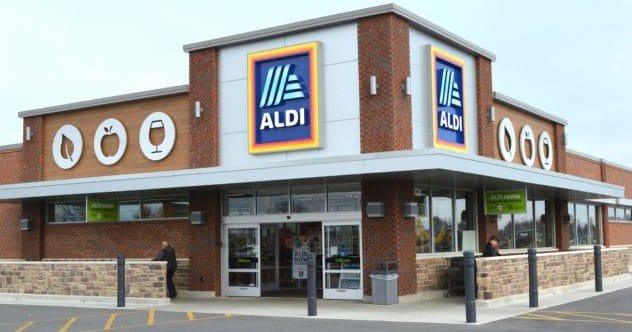Aldi stores are famous for their affordable prices on everyday items. But have you ever wondered how they manage to keep their prices so low, and what exactly sets them apart from other grocery stores? Here are ten surprising facts about Aldi that you might not know!
10. Most Stores Have the Same Layout
If you’re looking for a specific item at Aldi, you’ll likely know exactly where to find it, even if you’re in a different location. That’s because most Aldi stores follow the same layout. This consistent design helps customers quickly navigate the store, saving time and making shopping more efficient.
Unlike most grocery stores that frequently reorganize their layouts to encourage longer shopping times and impulse buys, Aldi focuses on simplicity and speed. This customer-friendly approach allows you to get in, get what you need, and get out without unnecessary delays.
9. The Founders Were Frugal… Really Frugal
Theo and Karl Albrecht, the founders of Aldi, were known for their deep-seated belief in keeping costs down. Their commitment to frugality wasn’t just a business strategy; it was a way of life.
Aldi’s “no frills” approach—keeping items in shipping containers and using a quarter cart system to save on labor—reflects this mindset. What’s truly remarkable is that the billionaire brothers maintained this frugality even after they could have easily afforded to splurge. Theo, in particular, was known for wearing cheap, ill-fitting suits and obsessively collecting pencil stubs to avoid buying new ones. He even critiqued a new store design for using paper that was too thick, emphasizing that thinner paper would save money.
8. Originally, No Produce Was Sold
Today, Aldi is recognized for its great deals on fresh fruits and vegetables. However, when Karl and Theo Albrecht took over their parents’ store in 1946, they initially decided not to sell any produce at all.
This decision was driven by their focus on maximizing profits and minimizing waste. By selling only non-perishable items and quickly removing unpopular products, the brothers rapidly expanded their business to nearly 300 stores in Germany by 1960. It was a surprising strategy that paid off!
7. Steel-Toed Shoes Are a Must for Employees
While many grocery stores require employees to wear non-slip shoes, Aldi takes workplace safety a step further. All employees must wear steel-toed shoes.
Unlike other stores where employees may specialize in one role, Aldi employees often handle various tasks, from cashiering to moving boxes and operating machinery. This versatility means they face a range of potential hazards, making steel-toed shoes a necessary part of their dress code. So, next time you’re at Aldi, remember that the cashier is well-protected!
6. Limited Stock: Around 1,400 Items on Average
Most grocery stores stock thousands of items to provide customers with a wide variety of choices. Aldi takes a different approach. On average, each Aldi store keeps only about 1,400 items in stock.
While this may seem limited compared to the 40,000 items at traditional grocery stores or the 100,000 at Walmart, it allows shoppers to navigate the store more quickly and efficiently. With fewer options, decisions are simpler, and checkout lines move faster. However, this also means that Aldi is more likely to run out of basic items, so it’s best to grab what you need when you see it!
5. You Might Be Pronouncing “Aldi” Wrong
If you’re from Europe or Australia, this might be old news. But for many North Americans, the pronunciation of “Aldi” may come as a surprise. While many in Canada and the U.S. pronounce it as “all-Dee,” the correct pronunciation features a hard “a” sound, similar to the name “Albert.”
Considering that Aldi is a German company named after its founders, Karl and Theo Albrecht, using the German pronunciation makes sense. Their last name is pronounced with the hard “a” sound, so the shortened version, “Albrecht Discounts,” should be pronounced the same way. Now you know!
4. Aldi Owns Trader Joe’s… Sort Of
Trader Joe’s, known for its unique and quirky products, is a favorite among many shoppers. Surprisingly, Aldi actually owns Trader Joe’s, or at least, a branch of Aldi does. Aldi Nord, which doesn’t operate in the United States, purchased Trader Joe’s from Joe Coulombe in 1979.
So, while Aldi Nord owns Trader Joe’s, it’s separate from the Aldi stores most Americans are familiar with, which are operated by Aldi Sud. Despite being distinct companies, both chains share similarities, such as low prices, limited options, and positive work environments.
3. A Cigarette Dispute Split the Company
Aldi is actually two separate companies: Aldi Sud and Aldi Nord. This division occurred in 1960 when brothers Karl and Theo Albrecht disagreed over whether to sell cigarettes in their stores.
Theo believed that selling cigarettes would attract more customers, while Karl worried about potential shoplifting and the store’s reputation. Unable to reconcile their views, they divided Germany, with Karl taking Aldi Nord in the north and Theo managing Aldi Sud in the south. As the stores expanded internationally, they remained separate entities. Today, Aldi Sud operates in the U.S. and most of southern Europe, while Aldi Nord is in France, the Netherlands, Poland, and Spain. Despite being separate, the stores are nearly identical, except for their logos.
2. The Infamous “Aisle of Shame”
Aldi is not just a discount grocery store; it’s also home to the “aisle of shame,” officially known as the “Aldi Finds Aisle.” This aisle features a rotating selection of random items like housewares and bedding that you might not have planned to buy.
The ever-changing nature of the aisle and the unbeatable prices often persuade shoppers to make impulse purchases. With a dedicated Facebook group for Aldi fans to share their finds, the aisle has gained a cult following, with many looking forward to grocery shopping just to see what treasures they can discover. Surprisingly, this aisle accounts for nearly 20% of Aldi’s annual sales!
1. A Discount on His Own Ransom
Theo Albrecht’s frugality was legendary. Despite his immense wealth, he was known for his shabby attire and reluctance to spend money. In 1971, when he was kidnapped for ransom, his kidnappers had to verify his identity because he didn’t look like a multimillionaire.
During negotiations, Theo managed to convince the criminals that his family wouldn’t pay the original ransom amount, negotiating it down to seven million German marks. To add to the story, he later claimed the ransom money as a business expense on his taxes. Now, that’s taking frugality to a whole new level!
From unusual origins to quirky employee policies and even a kidnapping with a negotiated discount, Aldi is full of surprises. Next time you shop there, you’ll have some fun facts to ponder while you snag those low-priced groceries.
What’s the most surprising thing you’ve learned about Aldi? Share your thoughts in the comments below!










